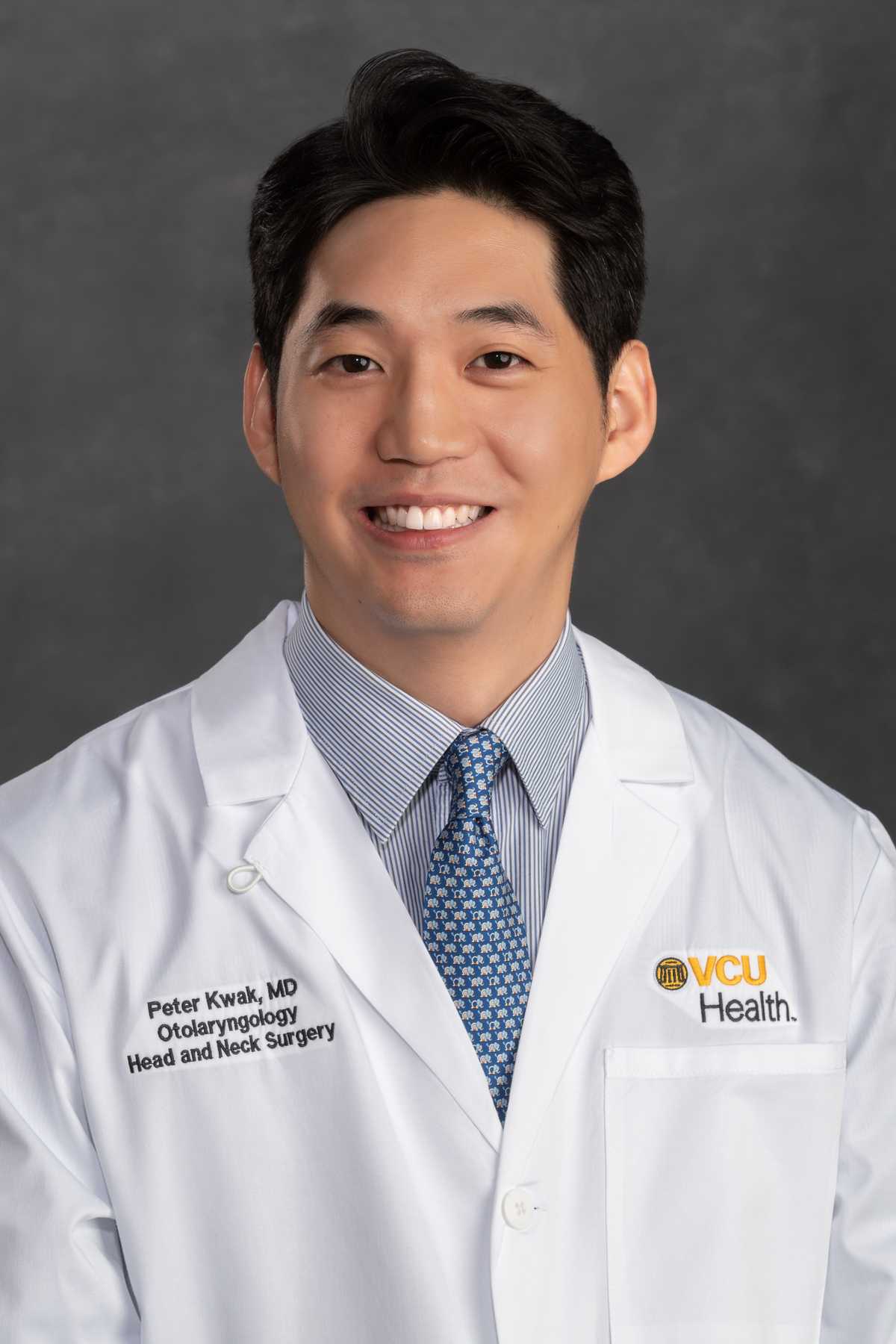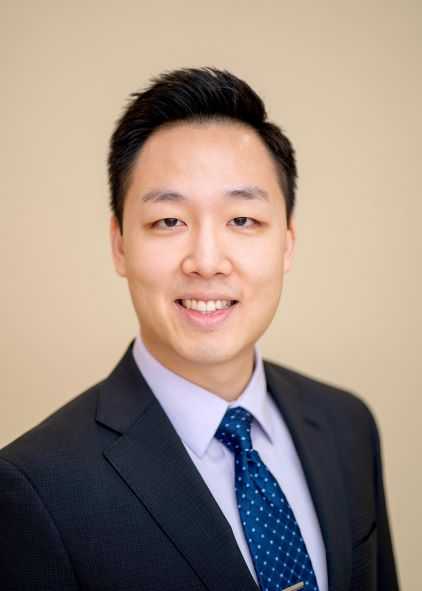Local Tissue Advancement: Reconstructing Superior Helical Rim Defect and Exposed Ear Cartilage After Mohs Surgery
Abstract
Reconstruction of external ear defects often poses various challenges due to the complex anatomy of the ear and its significant role in overall facial aesthetics. The location of the defect independently impacts the repair as various locations present distinct, additional factors to consider during planning. Specifically, defects of the superior auricle complicate the reconstructive process, due to the role of the helical root and superior rim in providing mechanical support for facial accessories such as glasses or hearing aids. The approach to reconstruction must be systematic while also being individually tailored in order to appropriately restore both optimal cosmesis and function.
The featured case involves the reconstruction of a full-thickness superior helix and auricular defect in a patient who wears eyeglasses with a cochlear implant on the same side. The discussion highlights the complexity of superior auricular reconstruction as well as the various surgical options used and challenges encountered.
Keywords
Ear reconstruction; helical rim reconstruction
Case Overview
Background
Reconstruction of the external ear poses unique surgical challenges given the innately elaborate anatomy of the ear, particularly at the superior auricle and helix. Despite the wide range of repair techniques available with commonly applied themes to surgical decision-making, there is no single, universally applicable algorithm. As reconstructive techniques continue to develop and evolve, further understanding and assessment of the various advantages and disadvantages to each method are warranted. As with any reconstructive surgery, repair of auricular defects must be individually tailored in order to achieve the most optimal aesthetic and functional outcomes.
Focused History of Patient
An 87-year-old male presented for reconstruction of a full-thickness ear defect following recent Mohs surgery for basal cell carcinoma (Figure 1A and 1B). The patient notably wore eyeglasses and had a history of ipsilateral cochlear implantation with ongoing daily use. The patient also expressed desire for a single-stage reconstruction.
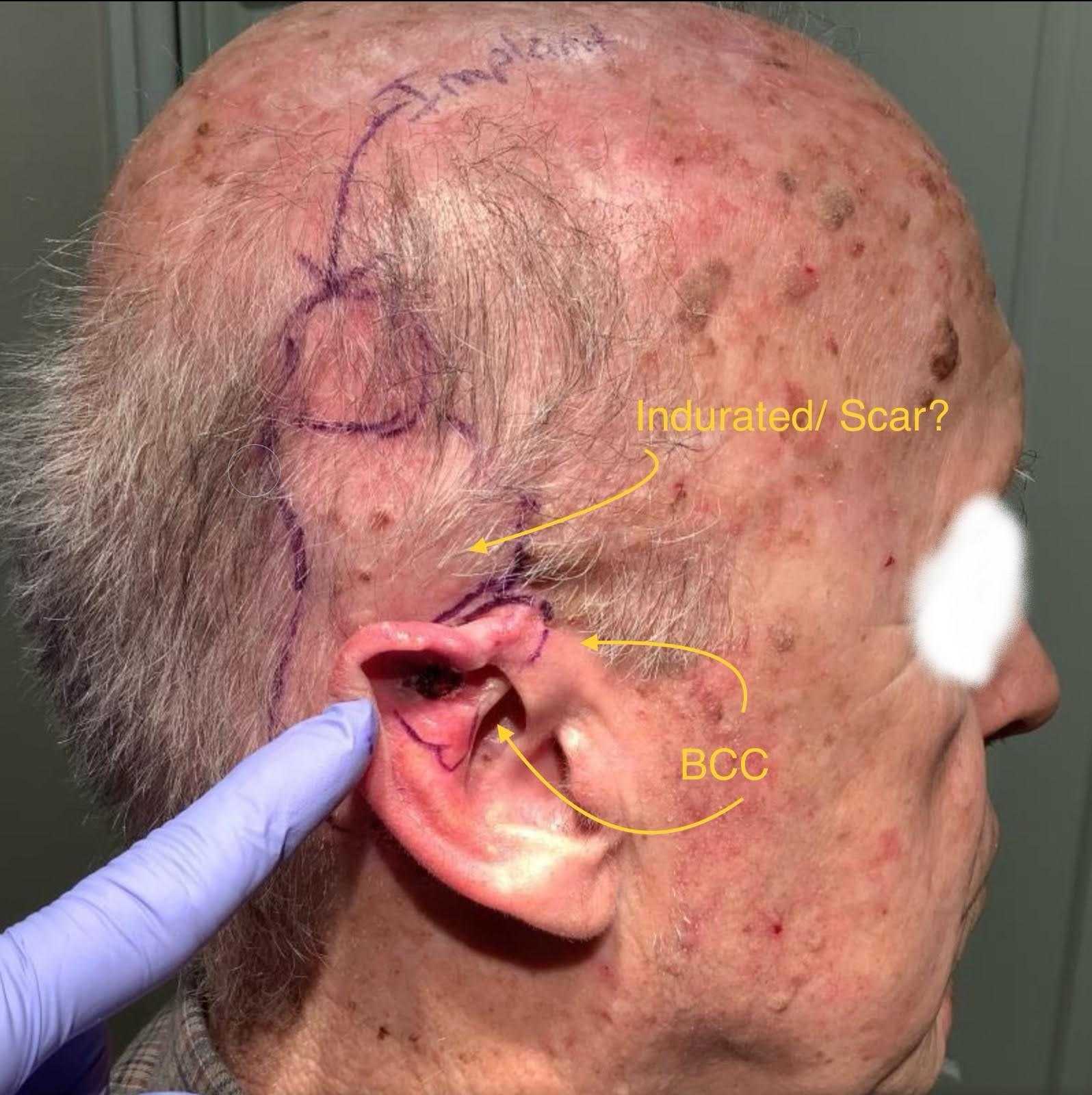
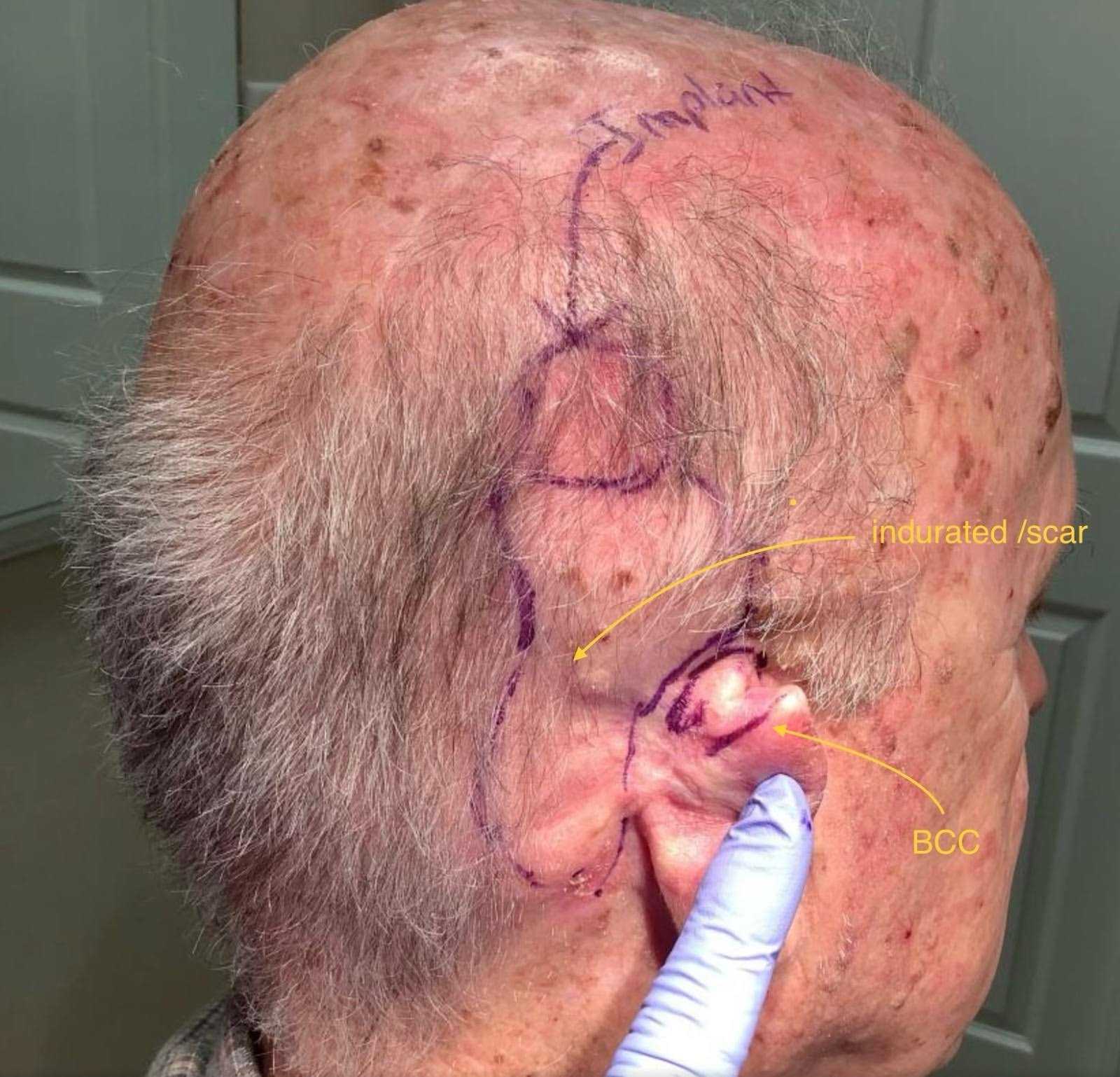
Figure 1. A (left): Pre-Mohs surgery image demonstrates basal cell carcinoma involving superior helix and antihelix. Cochlear implant site is labeled for surgical planning. Indurated scar was also marked posterior to the ear and inferior to the cochlear implant and was biopsied and found to be non-malignant. B (right): Basal cell carcinoma extends posteriorly along superior helix that will result in full-thickness skin defect.
Physical Exam
Exam revealed a 2x3-cm full-thickness defect of the superior auricle involving the upper quarter of the ear. The defect involved the helical root, superior helical rim, superior and inferior antihelical crura, and the triangular fossa. There was a small amount of remaining triangular fossa and scapha skin, cartilage, and soft tissue. The wound also extended inferiorly into the middle third of the ear where there was a partial-thickness defect involving the antihelical skin with bare cartilage exposure (Figure 2).
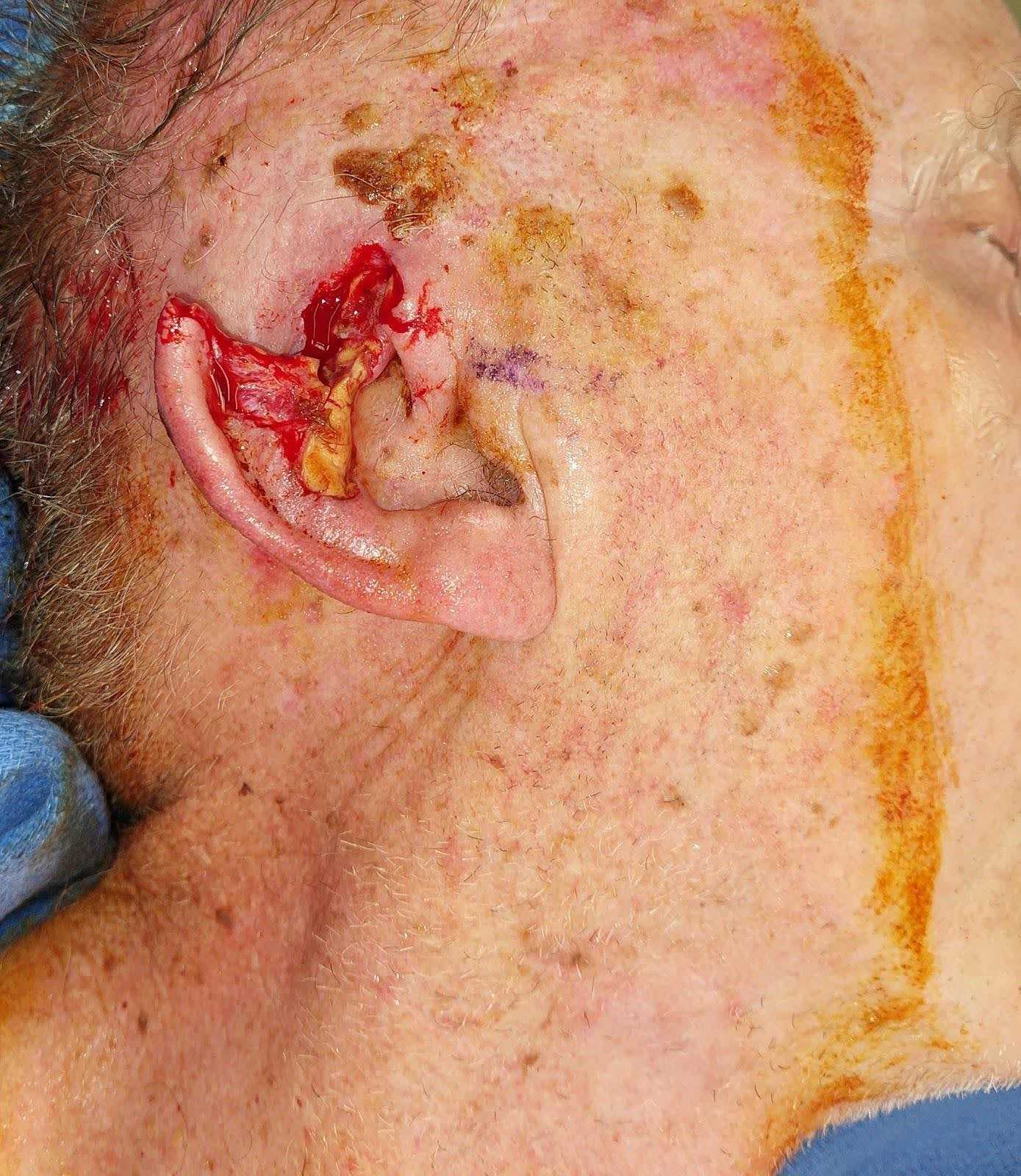 Figure 2. Preoperative exam. Demonstrating superior auricular defect involving the upper one-third of the helical rim with exposed cartilage along the inferior antihelix.
Figure 2. Preoperative exam. Demonstrating superior auricular defect involving the upper one-third of the helical rim with exposed cartilage along the inferior antihelix.
Imaging
There was no imaging performed given that the patient had already undergone definitive Mohs resection by another provider and physical exam revealed no concern for persistent local or regional disease.
When planning for ear reconstruction, preoperative imaging is generally only necessitated in cases where there is suspicion for either new or residual disease. This includes local or regional disease involving the temporal bone, parotid gland or associated soft tissues, or cervical lymphadenopathy.
Natural History
Ear deformities arise from various pathologies, including both congenital and acquired causes. Acquired ear defects most commonly arise from cutaneous malignancies and trauma. The superior auricle and helix are among the most common sites for auricular skin cancers given their increased sun exposure and comprise up to 55% of these malignancies.1–3 The helix is one of most common sites of the ear involved in reconstruction. These defects are typically full-thickness involving both the skin and underlying cartilage, complicating the reconstructive process.
Options for Treatment
There are a variety of surgical techniques available for reconstruction of the superior auricle and helix. The choice of approach is dependent on the size and location of the defect as well as the degree of cartilage involvement. Options range from primary closure and wedge excisions for smaller defects to advancement flaps and composite reconstruction for larger defects.4 Reconstruction may take place in single-stage or multi-stage fashion.
Rationale for Treatment
The ear is a highly visible structure and as a result, significantly contributes to an individual’s overall facial symmetry and aesthetic. Furthermore, the superior helical rim and helical root carry unique functional significance when compared to the rest of the ear as they provide mechanical support for patients who wear glasses or hearing aids.4 The vertical height and projection from the mastoid and skull serve as a scaffold on which such devices can be seated. Thus, reconstruction of such chondrocutaneous defects is imperative in restoring both cosmesis and function.
Additionally, reconstruction and repair should always entail complete coverage of any grossly exposed bare cartilage. Failure to do so would ultimately lead to chronic infection and necrosis, resulting in cosmetic and structural deformity and morbidity.
Special Considerations
Planning for superior auricular reconstruction should include assessing for routine eyeglasses or hearing aid usage given the superior helix’s role in providing functional support for these devices. As with any surgery, the underlying health of the patient should be taken into consideration given the associated varying anesthesia risk for different approaches and need for staged reconstruction with multiple surgeries.
Surgical Procedure
This case features an elderly patient who desired single-stage reconstruction of a superior auricular defect. Reconstruction was performed using local tissue advancement, including advancing the remnant auricular tissue to recreate the superior helical defect while advancing the conchal skin to cover the exposed cartilage along the antihelix.
The procedure began with a thorough examination of the wound bed noting the defect's size, location, involvement of ear subsites, exposure of underlying cartilage, and integrity of surrounding tissue. The wound edges were debrided to healthy tissue to ensure optimal skin viability. Any exposed cartilage was carefully examined for the presence of overlying perichondrium, as its absence precludes direct skin graft placement without the presence of a vascularized wound bed. The skin surrounding the exposed cartilage was circumferentially elevated anteriorly along the concha to the level of the posterior external auditory canal opening and posteriorly to the middle helix. Additionally, the skin overlying the triangular fossa was raised anteriorly to the inferomedial helical edge.
Once adequate elevation of the surrounding skin was performed, the remaining auricular tissue and structures were advanced and rearranged to recreate the contour of the superior helical rim. In this case, the inferolateral aspect of the middle helix was advanced superomedially to recreate the new superior helix. This was secured to the adjacent preauricular and postauricular skin using buried Vicryl sutures for the soft tissue and polydiaxanone sutures (PDS) for the cartilage. Any redundant cartilage that proved difficult to cover and did not serve purpose in restoring shape or function was excised. While doing this, care must be taken to preserve any cartilage that contributes to the overall contour of the ear, such as the medial ledge of the antihelix. Additional cartilage or surrounding skin may also be resected at this time to achieve optimal facial aesthetic with appropriate ear projection, specifically by setting an appropriate auriculocephalic angle of around 30 degrees from the mastoid. While it is appropriate to excise redundant cartilage, care must be taken to preserve any cartilage that contributes to the overall contour of the ear, including the medial ledge of the antihelix.
The conchal bowl skin and remnant triangular fossa skin were then advanced posterolaterally to cover the exposed cartilage along the middle antihelix and scapha. The skin was then closed over the cartilage in a tension-free manner. Finally, the skin flap was further tacked down to the underlying cartilage to avoid an auricular hematoma by using a transauricular quilting stitch with chromic suture (alternatively, a bolster can be applied). Auricular hematoma, if left unaddressed, would lead to underlying cartilage necrosis and resulting cosmetic deformity.
Notably, monopolar cautery was avoided in this case due to the patient’s existing ipsilateral cochlear implant.
Immediate postoperative results revealed appropriate repair of the defect, with restoration of the auricular shape and adequate tissue coverage (Figure 3).
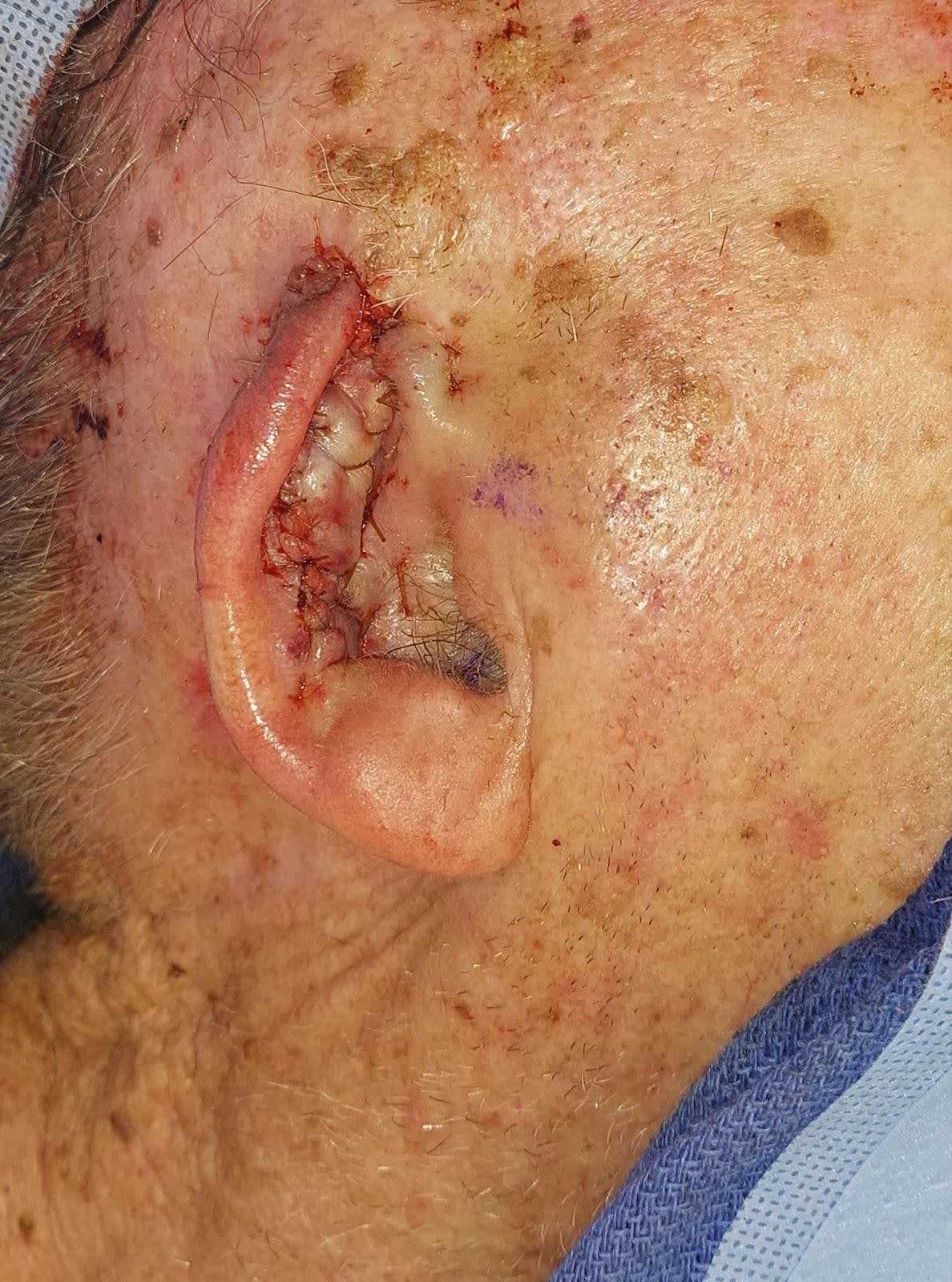
Figure 3. Immediate postoperative result.
Antibiotics were prescribed postoperatively given the cartilage exposure to prevent infection and subsequent necrosis. Postoperative course was uncomplicated with appropriate healing, and the patient was cleared to wear glasses and hearing aid at 1 month postoperatively (Figure 4).
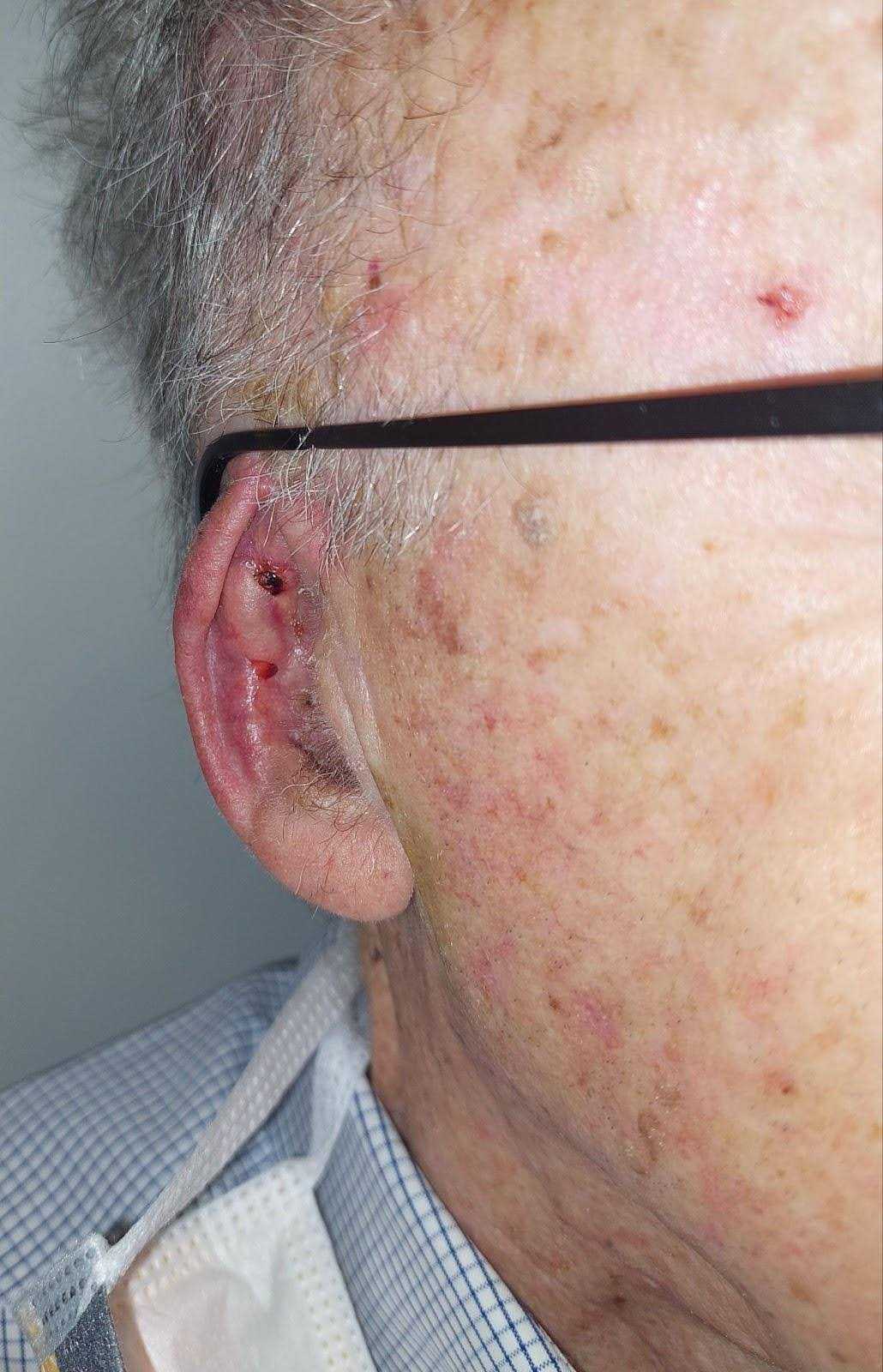 Figure 4. One-month postoperative result. Patient was cleared to wear glasses, which was shown to be adequately supported by the newly reconstructed superior helix.
Figure 4. One-month postoperative result. Patient was cleared to wear glasses, which was shown to be adequately supported by the newly reconstructed superior helix.
Discussion
Reconstruction of the superior auricle and helix, cited as the most common sites of auricular defects, is an intricate process with both cosmetic and functional facets.2, 3 The complex contour of the auricle is not only demonstrated by its many curves and folds, but also by its relative position to the temple, eyes, nose, and other core components of the face. As a result, even the slightest irregularities or asymmetries may be noticeable.4 At the same time, it acts as a mechanical scaffold for various devices, such as hearing aids and eyeglasses. Therefore, reconstruction of these defects must be both individually tailored and methodically executed in order to restore the most optimal aesthetic and functional outcome for the patient.
As with all head and neck reconstruction, the range of reconstructive options for the superior auricle and helix is widely diverse and selection of the ideal technique is determined by the characteristics of the defect. These deformities are characterized by their location on the auricle, their size, and the presence or absence of disease beyond the auricle itself. In general, superior helical defects less than 1.5 cm are considered small, 1.5–2 cm as medium, and greater than 2 cm as large. The location of the defect is further described as the helix, the superior, middle, or inferior third of the auricle, or the lobule. The extent of the defect is characterized by the tissues involved or exposed as well as the availability of surrounding tissue.5 The auricle is composed of multiple tissue types including skin, subcutaneous fat, perichondrium, and cartilage. The underlying elastic cartilage of the ear requires delicate handling and complete tissue coverage as bare cartilage exposure to air results in irreparable damage and ultimately necrosis and cosmetic deformity. While the presence of perichondrium can serve as a vascularized bed for overlying grafting or skin transfer, bare cartilage requires additional vascularized tissue in the forms of pedicled skin or fascial (temporoparietal) flaps.6
Reconstruction of superior auricle and helical rim defects is conducted in a stepwise fashion based on the above factors. Strategies may often combine multiple reconstructive techniques and may be conducted in a single-stage or a multi-stage fashion. A systematic review of auricular reconstruction techniques conducted by Noor et al provided an algorithmic approach to addressing these defects.4 Small superior helical auricular defects are generally amenable to primary closure given the well developed subcutaneous layer and resultant laxity along the free edge of the helical rim. If primary closure is not possible, wedge excision is generally adequate for defects less than 1.5 cm. As defects become larger, the structural integrity becomes more compromised resulting in the need for reestablishment of the underlying framework and base. Advancement and redistribution of the adjacent residual auricular tissues provides the best aesthetic outcomes, making advancement flaps the mainstay in reconstruction in such larger defects.6
The complexity of reconstruction varies by the degree of cartilage defect. Partial-thickness defects sparing the cartilage may be addressed with full-thickness skin grafts; however, presence of remaining perichondrium must be confirmed as the skin graft requires a vascularized wound bed to survive. Partial-thickness defects with either intact anterior or posterior skin may also allow skin graft placement without cartilage grafting if involving structurally insignificant locations (i.e. conchal bowl). If the partial-thickness defect violates cartilage in structurally critical areas, such as the helical rim, cartilage grafting is advisable to prevent delayed structural collapse. Full-thickness defects with lack of both anterior and posterior skin require composite reconstruction, which may entail a chondrocutaneous advancement flap, a free cartilage autograft from the contralateral auricle, or an allograft covered by a vascularized advancement skin flap.4
As advancement flaps rely on adjacent tissue for reconstruction, understanding the underlying vascular anatomy of the entire ear is imperative for optimal operative planning. The main arterial contributions of the ear include branches of the external carotid artery. The superficial temporal artery (STA) and its named three anterior auricular branches (inferior, middle, and superior) provide perfusion to the anterior aspect of the ear while the postauricular artery (PAA) courses along the posterior auricular crease and provides blood supply to the posterior aspect (Figure 5). Branches from these arteries subsequently travel towards each other and form anastomotic networks and arcades to further perfuse various locations throughout the ear. Notable anastomotic networks between these two arteries occur in the concha, the helix, the antihelix, tragus, and the earlobe. These vessels provide vast blood supply allowing for full-thickness helical rim advancement while preserving flap vascularity.5 Defects that disrupt such vascular networks may compromise the viability of regional tissue that rely on the same vascular supply.4
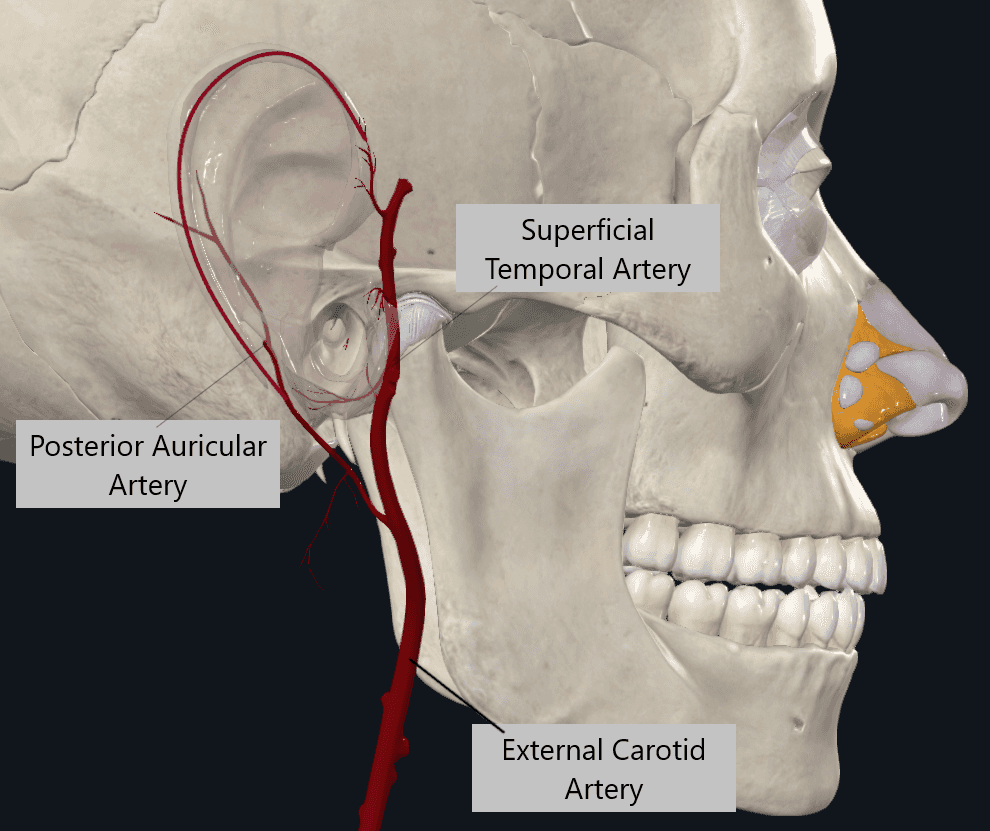 Figure 5. Vascular anatomy of the ear. Terminal branches of the external carotid artery provide the anterior and posterior blood supply to the auricle. The STA gives rise to the anterior auricular artery that provides blood supply for the anterior aspect, while the PAA provides blood supply for its posterior aspect. An additional blood vessel that runs through the helical rim forms an anastomotic network between the superior branch of the anterior auricular artery and the PAA.
Figure 5. Vascular anatomy of the ear. Terminal branches of the external carotid artery provide the anterior and posterior blood supply to the auricle. The STA gives rise to the anterior auricular artery that provides blood supply for the anterior aspect, while the PAA provides blood supply for its posterior aspect. An additional blood vessel that runs through the helical rim forms an anastomotic network between the superior branch of the anterior auricular artery and the PAA.
Various advancement and local rotational flaps have been described for composite reconstruction of the superior auricle and helix, each with its own advantages and disadvantages. Chondrocutaneous advancement flaps are commonly employed given their tissue match, subsequently sparing the need for an additional donor site. The Antia-Buch advancement technique is a classically used chondrocutaneous flap reconstruction of small- to medium-sized superior helical full-thickness defects. This method involves creating two separate vascularized flaps along the helical sulcus into an anterior skin-cartilage flap and posterior skin only flap (Figures 6). The flap is supplied by the superior branches of the anterior auricular artery along its cephalad portion and branches of the posterior auricular artery along its caudal aspect (Figure 5).7 For larger defects up to 2.5 cm, a V-Y advancement of the helical crus and root with trimming of the scaphoid fossa cartilage may be incorporated to provide additional length and reduce tension on the closure.8, 9 This technique remains a cornerstone in upper helical reconstruction given its versatility and simplicity in providing a single-staged composite reconstruction. Disadvantages to this technique include extensive dissection of the ear and resection of healthy scaphal cartilage with subsequent reduction in overall width circumference, ultimately distorting auricular symmetry.9
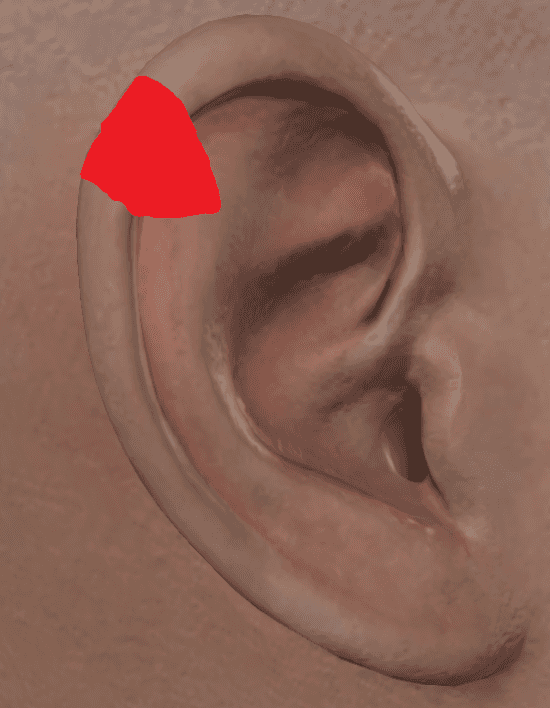
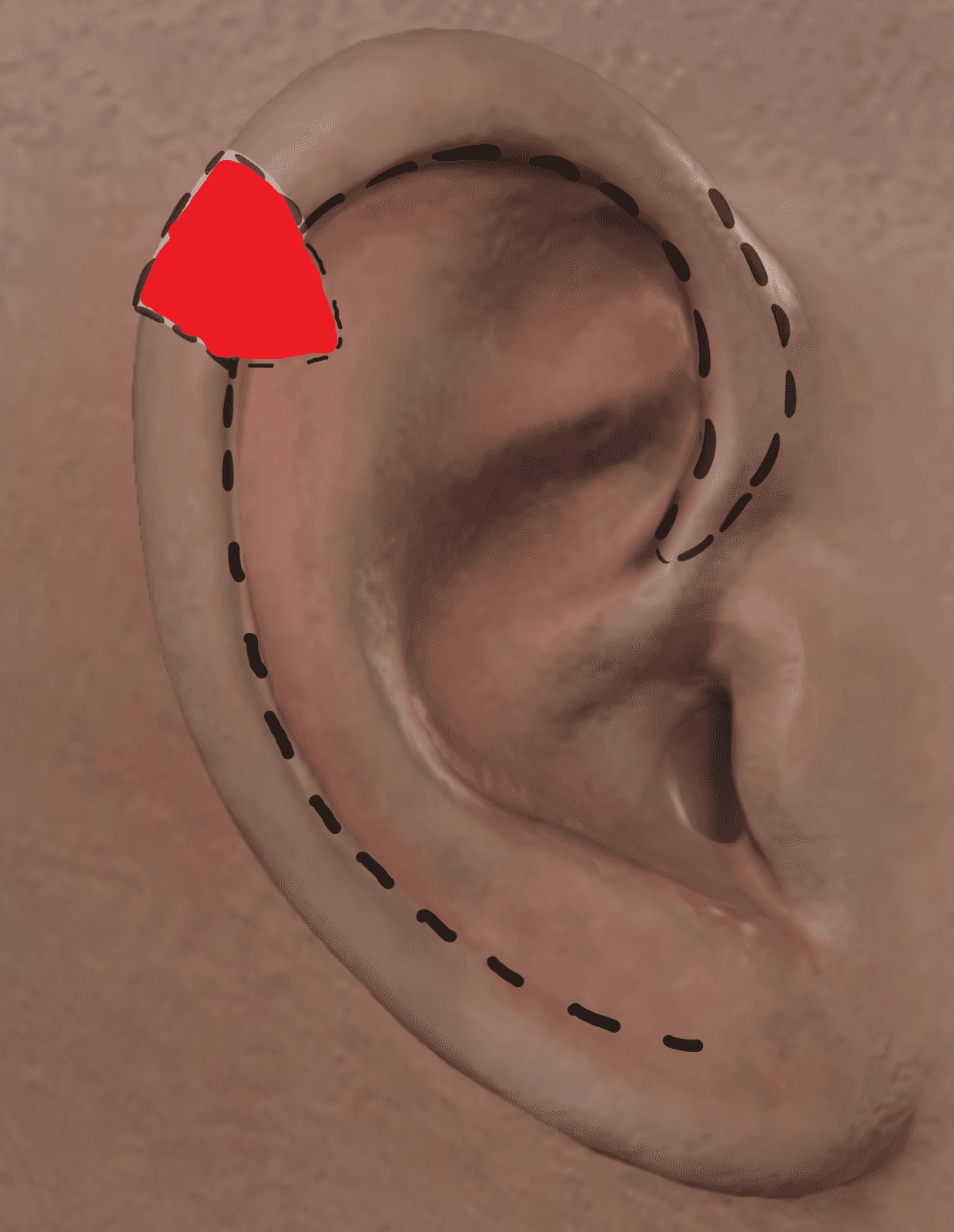
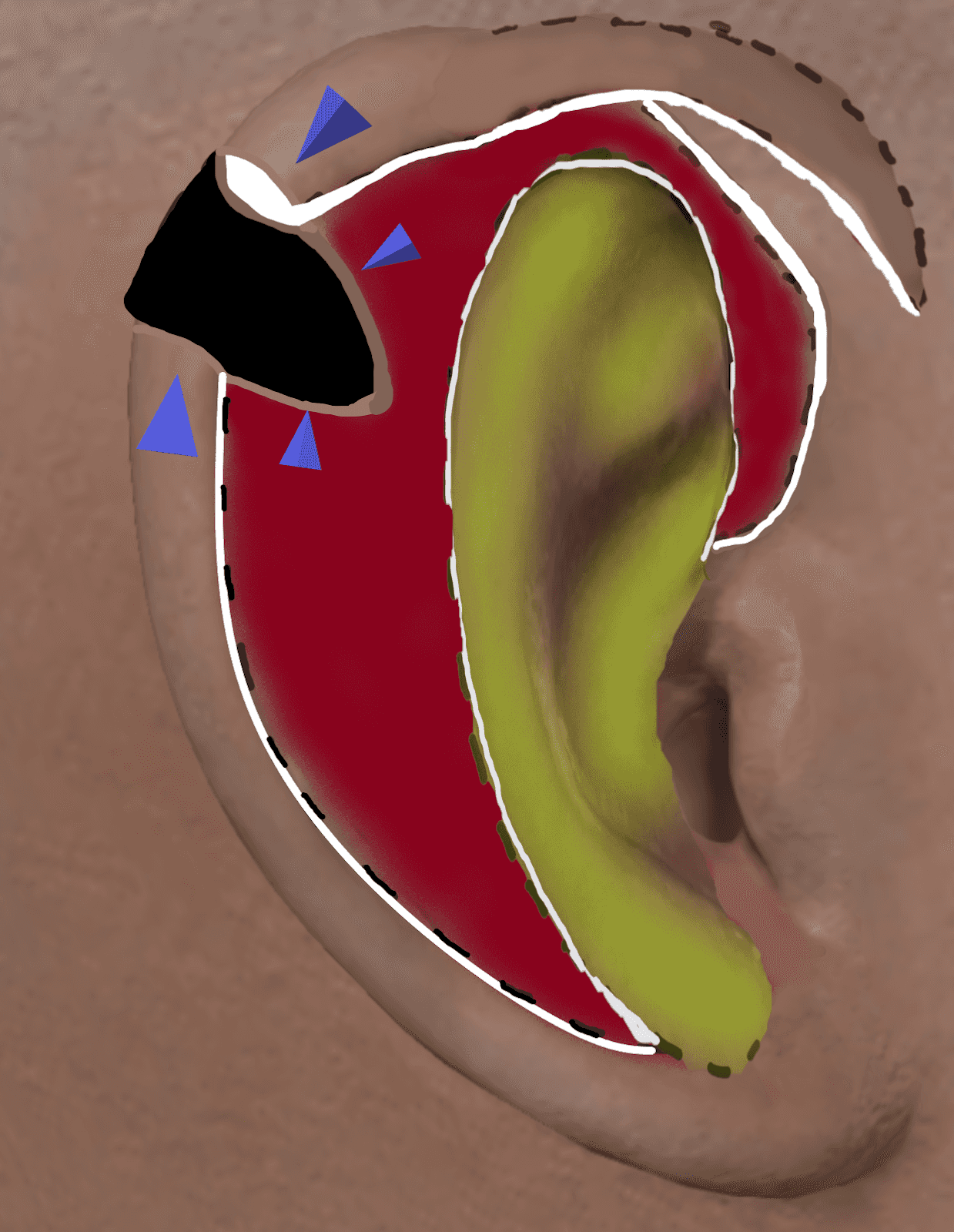
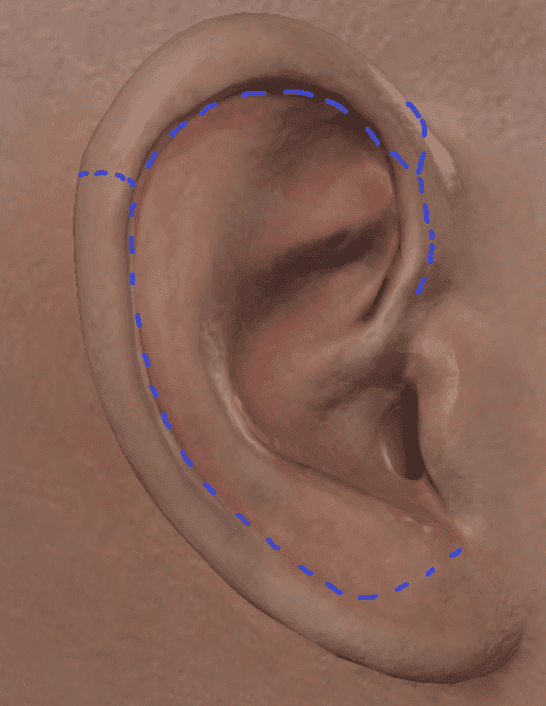 Figure 6. Modified Antia-Buch technique by Maglic et al (from left to right). A) Solid red area represents full-thickness tissue defect involving helical rim skin and cartilage. B) Dashed black lines represent incisions with creation of anterior and posterior vascularized flaps. C) Anterior flap (highlighted in green) includes both anterior auricular skin and cartilage along the antihelix, triangular fossa, and concha. This flap is raised in the supraperichondrial tissue plane (maroon), while the posterior flap is raised with the posterior auricular skin and cartilage along the helical rim. D) Dashed blue lines represent the final incision line and appearance upon closure.
Figure 6. Modified Antia-Buch technique by Maglic et al (from left to right). A) Solid red area represents full-thickness tissue defect involving helical rim skin and cartilage. B) Dashed black lines represent incisions with creation of anterior and posterior vascularized flaps. C) Anterior flap (highlighted in green) includes both anterior auricular skin and cartilage along the antihelix, triangular fossa, and concha. This flap is raised in the supraperichondrial tissue plane (maroon), while the posterior flap is raised with the posterior auricular skin and cartilage along the helical rim. D) Dashed blue lines represent the final incision line and appearance upon closure.
Numerous modifications to this technique have emerged through the years to address these issues. Most involve excising other areas of the ear to provide enhanced mobilization. For example, one modification described by Franssen and Frechner involves excising a horizontal wedge of ear lobe tissue with subsequent advancement of the tissue caudal to the defect (Figure 7). Violation of the root of the helix and resection of scaphal cartilage is thus avoided, thereby maintaining the original width of the ear. However, this is done at the sacrifice of vertical height given incorporation of the ear lobe.8 Despite these changes in auricular dimensions, differences are typically minimal in nature and subtle in appearance, especially when used in defects less than 2.5 cm.4 Even in cases where significant asymmetry is noticed between the opposing ears after reconstruction, height or width reduction can easily be performed on the contralateral ear to restore symmetry.
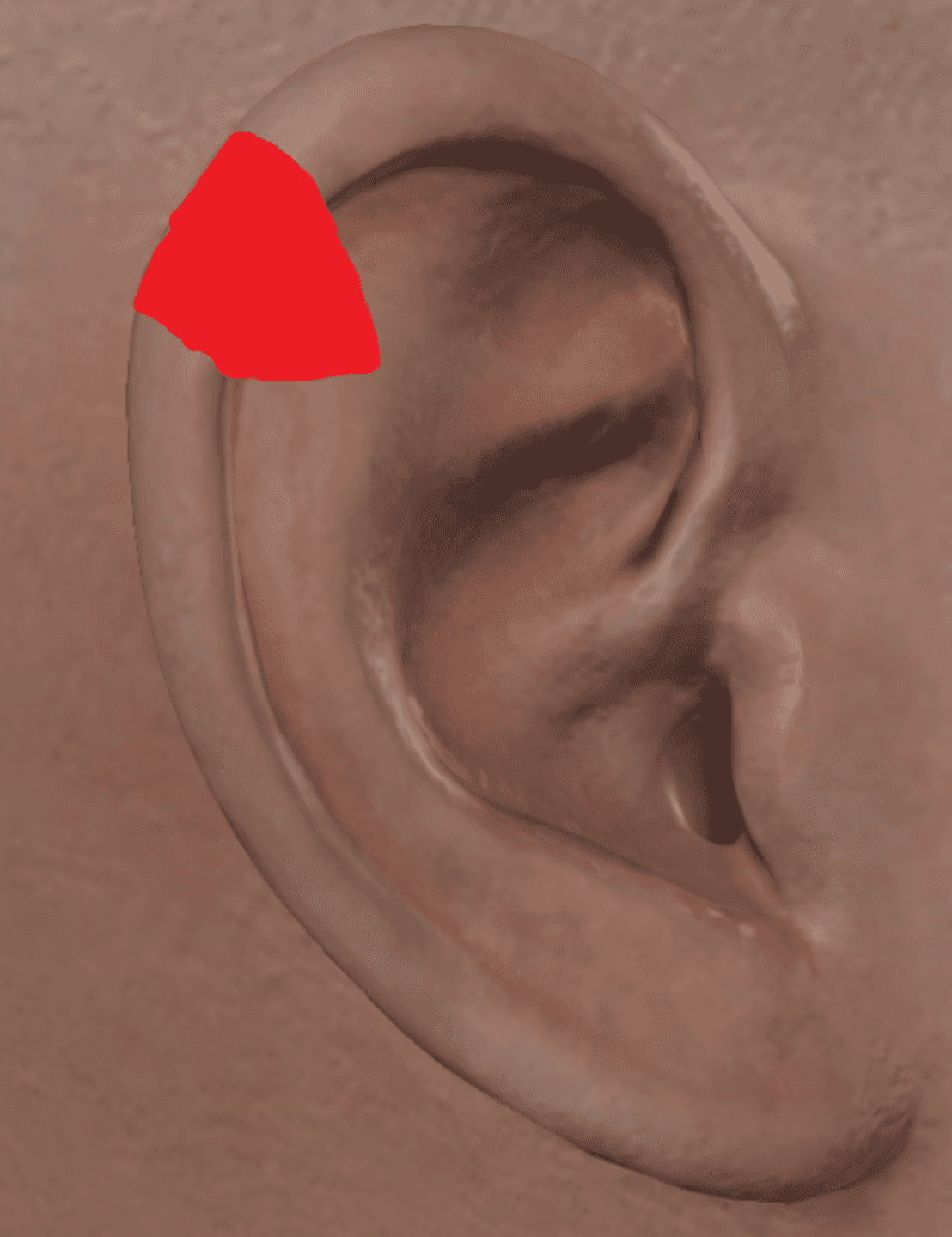
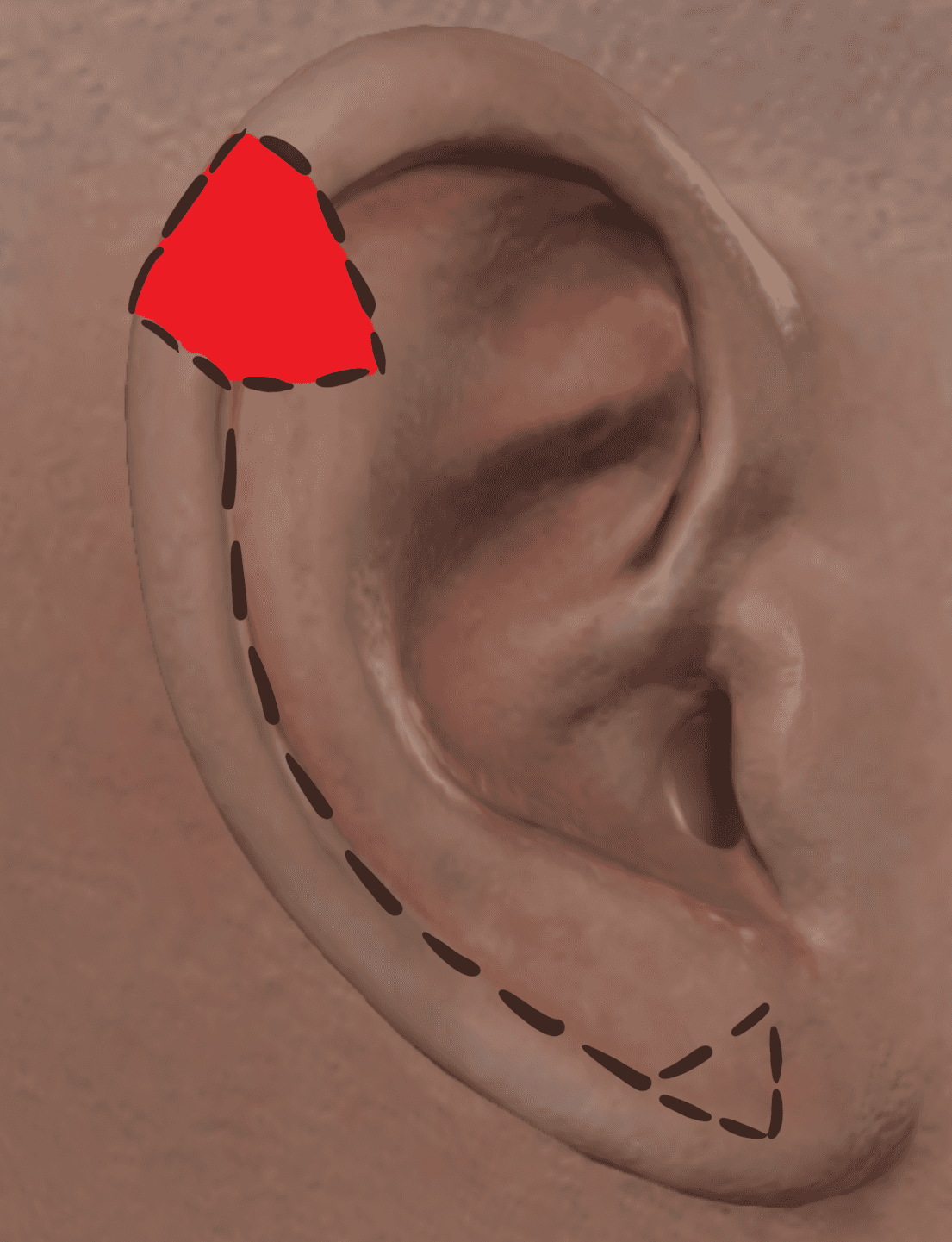
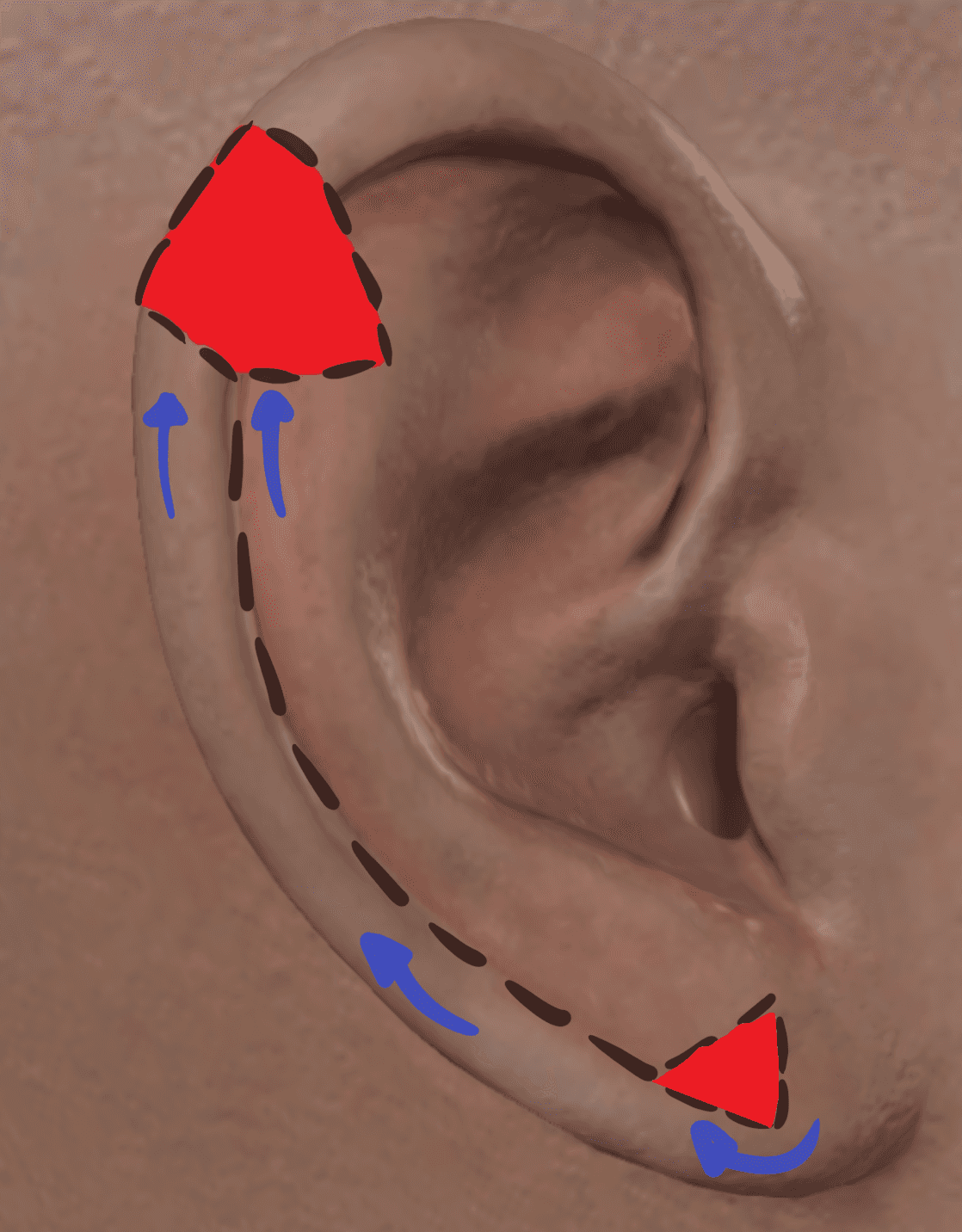
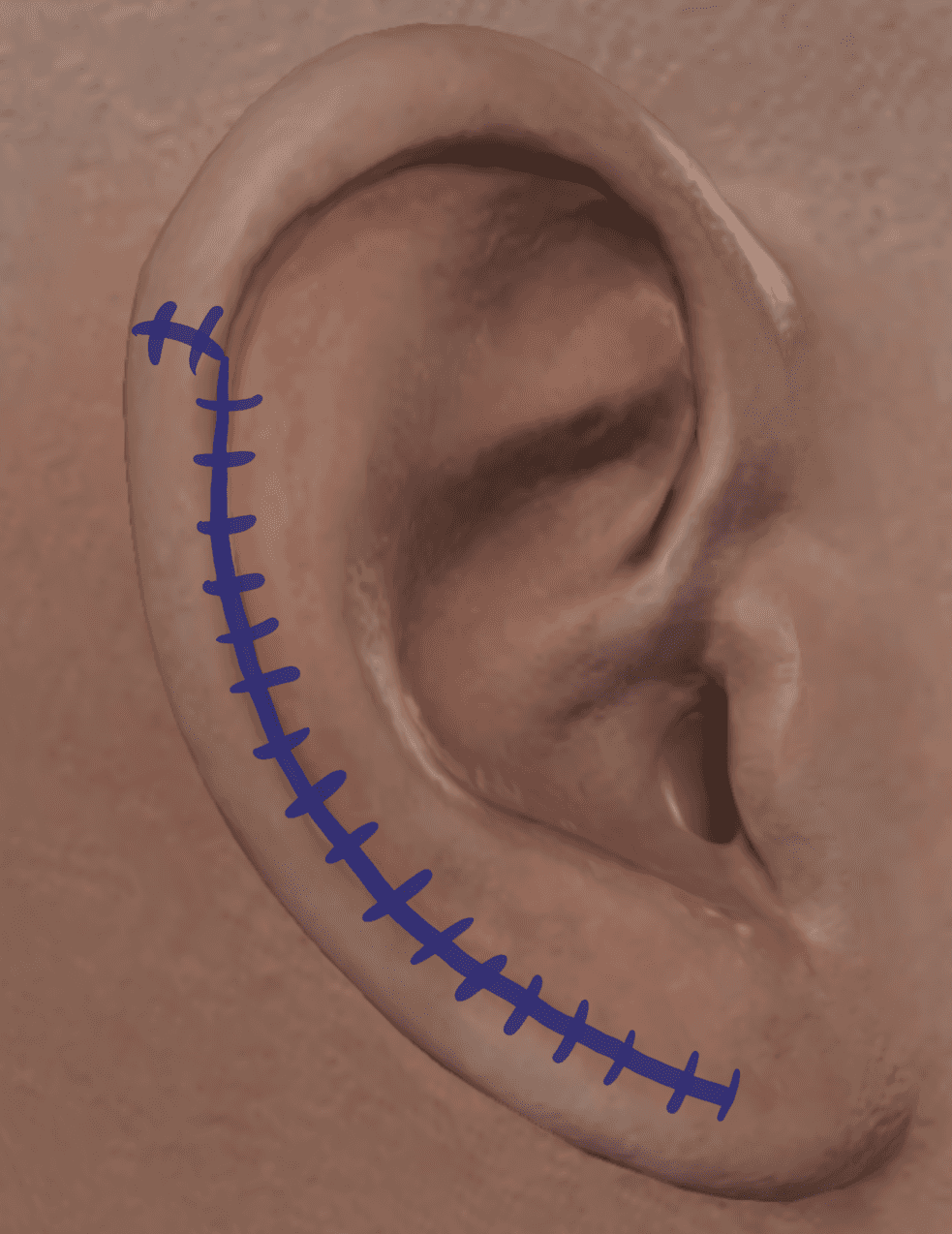 Figure 7. Franssen & Frechner’s Technique (from left to right). A) Solid red represents full-thickness tissue defect involving the helical rim skin and cartilage. B) Dashed black line represents full-thickness incision along the helical rim. Blood supply is based inferiorly near the lobule. C) The helical rim flap is advanced superiorly to close the superior helical defect, while the standing cone deformity is excised (red triangle along the lobule). D) Blue lines represent the final incision line and appearance upon closure.
Figure 7. Franssen & Frechner’s Technique (from left to right). A) Solid red represents full-thickness tissue defect involving the helical rim skin and cartilage. B) Dashed black line represents full-thickness incision along the helical rim. Blood supply is based inferiorly near the lobule. C) The helical rim flap is advanced superiorly to close the superior helical defect, while the standing cone deformity is excised (red triangle along the lobule). D) Blue lines represent the final incision line and appearance upon closure.
For skin only reconstruction options, cutaneous advancement flaps, especially those based on the superior auricular artery branch of the STA, are also commonly employed for upper helical reconstruction.2 Similarly, the abundance and laxity of soft tissue and conchal cartilage in the postauricular area enable these flaps to be of high reconstructive utility, especially for larger defects. Similarly, preauricular advancement and transposition flaps, based on random arterial supply arising from the STA, are also popular options for reconstructing large superior helical defects greater than 1.5 cm. However, these are commonly cutaneous-only flaps and need to be combined with a separate cartilage graft harvest when utilized in composite reconstruction of full-thickness defects.4
Lastly, postoperative antibiotic prophylaxis is a debated topic within the realm of ear wounds and defects. There is controversial supporting data, especially in atraumatic reconstructive wounds that are not grossly contaminated. When used, the choice of antibiotic (often an oral fluoroquinolone such as Ciprofloxacin) centers on targeting gram-negative bacteria, with specific care to cover Psuedomonas aeruginosa species, the most common bacteria causing cartilage infection and damage.10 Route of antibiotic administration, oral versus topical, is also a controversial topic. Some authors advocate for use of topical mafenide acetate, as it is believed to have good penetration through cartilage.11 Further investigation delineating the necessity or an ideal prophylactic agent in auricular reconstruction is warranted.
Equipment
No special equipment.
Disclosures
Nothing to disclose.
Statement of Consent
The patient referred to in this video article has given their informed consent to be filmed and is aware that information and images will be published online.
Citations
- Blake GB, Wilson JS. Malignant tumours of the ear and their treatment. I. Tumours of the auricle. Br J Plast Surg. 1974;27(1):67-76. doi:10.1016/0007-1226(74)90065-4.
- Evin N, Evin SG. Reconstruction of full-thickness helical defects using a superior auricular artery-based postauricular chondrocutaneous flap. Ann Plast Surg. 2023 Sep 11. doi:10.1097/SAP.0000000000003677.
- Tolleth H. A hierarchy of values in the design and construction of the ear. Clin Plast Surg. 1990 Apr;17(2):193-207.
- Noor A, Thomson N. Reconstruction of partial auricular skin cancer defects: a review of current techniques. Curr Opin Otolaryngol Head Neck Surg. 2023;31(4):260-268. doi:10.1097/MOO.0000000000000894.
- Zilinsky I, Cotofana S, Hammer N, et al. The arterial blood supply of the helical rim and the earlobe-based advancement flap (ELBAF): a new strategy for reconstructions of helical rim defects. J Plast Reconstr Aesthet Surg. 2015;68(1):56-62. doi:10.1016/j.bjps.2014.08.062.
- Brent B. The acquired auricular deformity. A systematic approach to its analysis and reconstruction. Plast Reconstr Surg. 1977;59(4):475-485.
- Maglic D, Sudduth JD, Marquez JL, et al. Modified Antia-Buch flap incorporating an extended temporal scalp incision. Plast Reconstr Surg Glob Open. 2023;11(2):e4797. doi:10.1097/GOX.0000000000004797.
- Abdelkader R, Malahias M, Abdalbary SA, Noaman A. Antia-Buch versus Franssen-Frechner technique. Plast Reconstr Surg Glob Open. 2021;9(3):e3498. doi:10.1097/GOX.0000000000003498.
- Stella C, Adam MF, Edward L. Helical rim reconstruction: Antia-Buch flap. Eplasty. 2015;15:ic55.
- Templer J, Renner GJ. Injuries of the external ear. Otolaryngol Clin North Am. 1990;23(5):1003-1018.
- Cho DY, Willborg BE, Lu GN. Management of traumatic soft tissue injuries of the face. Semin Plast Surg. 2021;35(4):229-237. doi:10.1055/s-0041-1735814.



